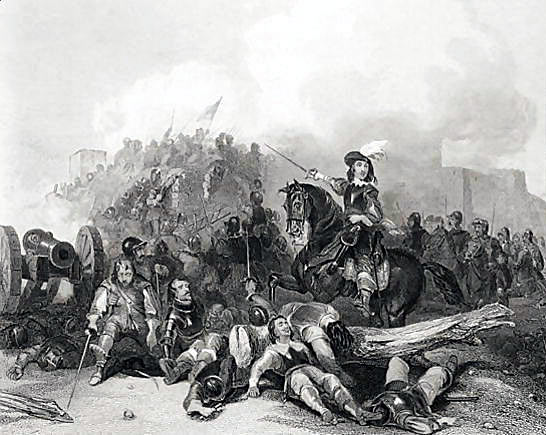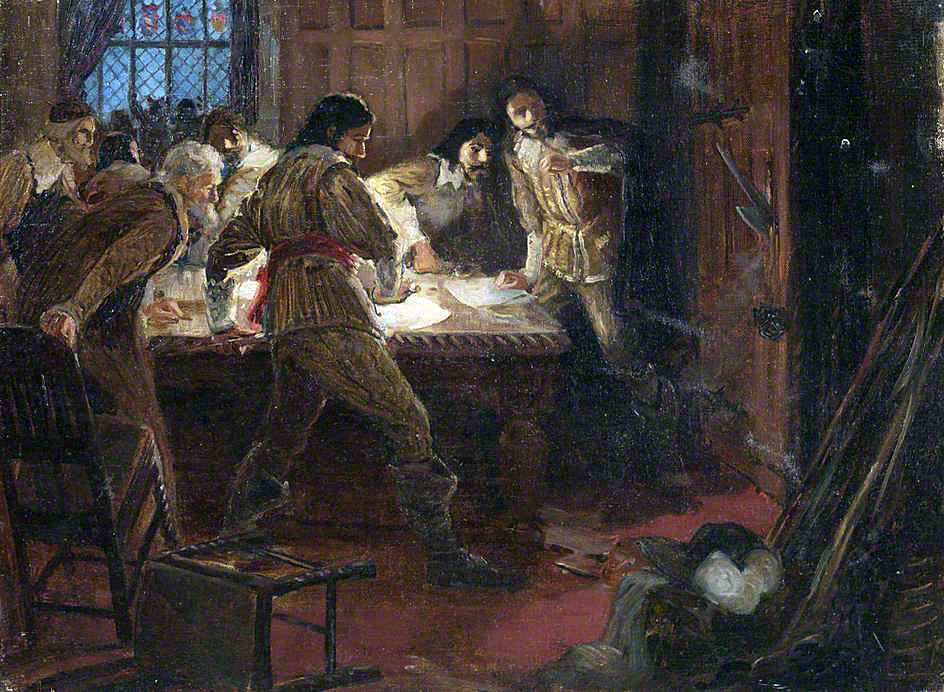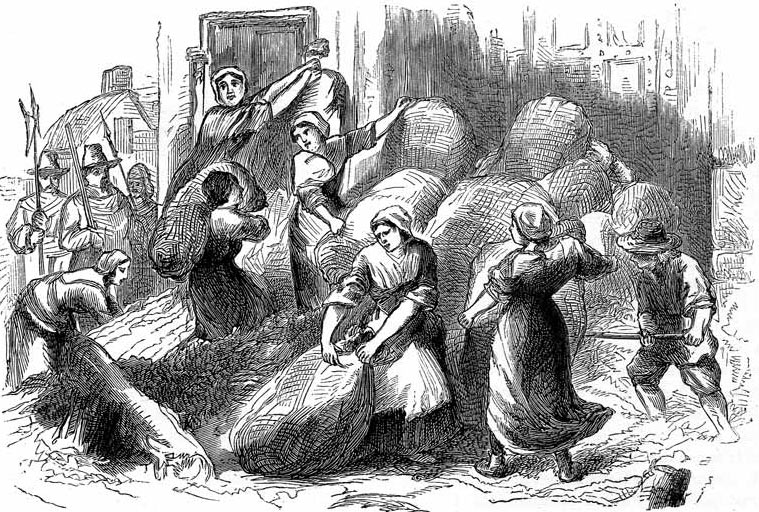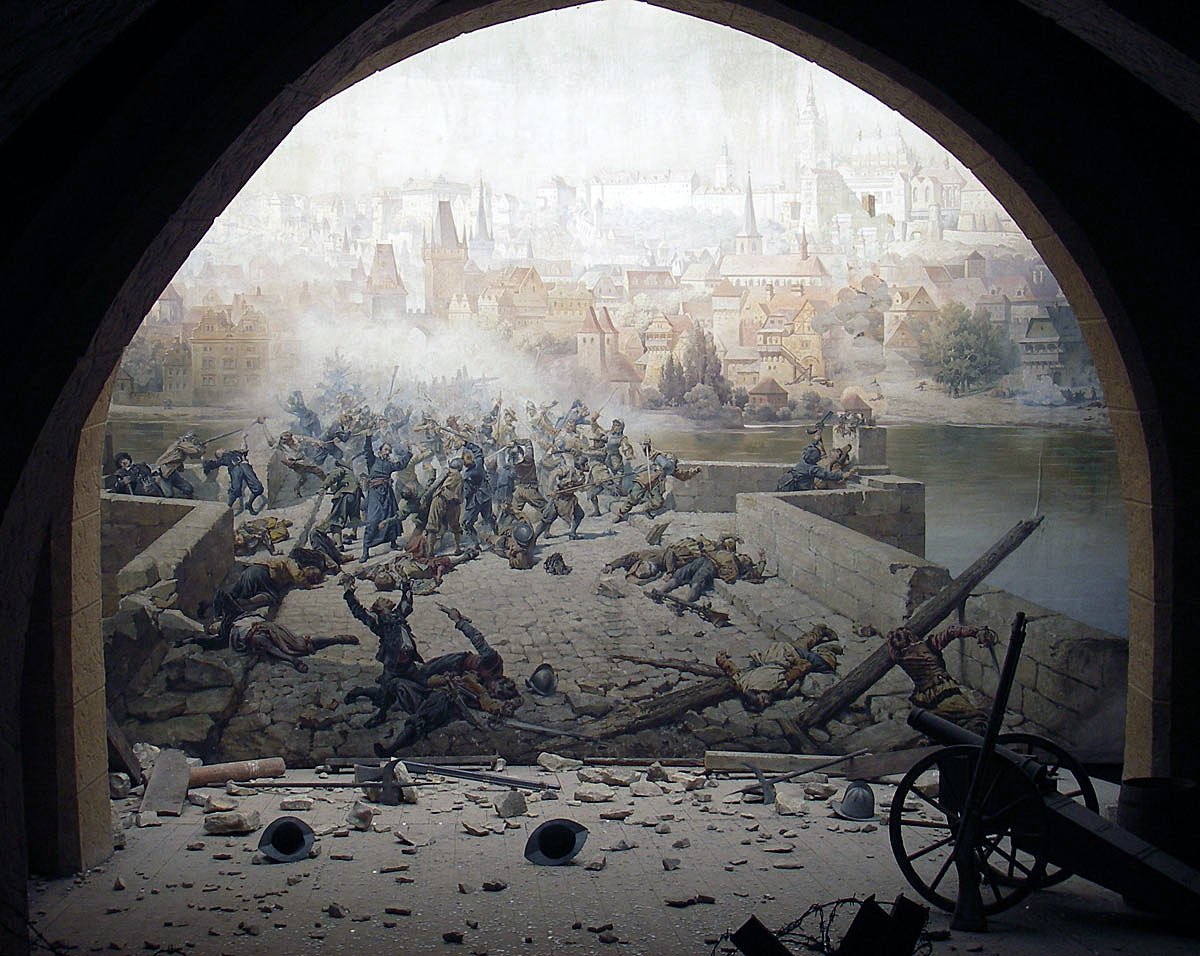The costly capture of Bristol by Prince Rupert’s Royalist army on 26th July 1643

Prince Rupert salutes the Royalist and Parliamentary casualties at the Storming of Bristol on 26th July 1643 in the English Civil War
The previous battle in the English Civil War is the Battle of Roundway Down
The next battle in the English Civil War is the First Battle of Newbury
To the English Civil War index
Battle: Storming of Bristol
War: English Civil War
Date of the Storming of Bristol: 26th July 1643
Place of the Storming of Bristol: the City of Bristol in the west of England.
Combatants at the Storming of Bristol:
The forces of King Charles I against the forces of Parliament.

Prince Rupert Royalist Commander of the army that stormed Bristol on 26th July 1643 in the English Civil War: picture by Sir Anthony van Dyck
Generals at the Storming of Bristol: Two Royalist forces met to attack the City of Bristol, Prince Rupert’s army from Oxford and Prince Maurice’s ‘Cornish’ army fresh from its success at the Battle of Roundway Down.
The Parliamentary garrison was led by Colonel Nathaniel Fiennes.
Size of the armies at the Storming of Bristol:
The Royalist armies jointly probably comprised around 4,500 horse and dragoons, around 6,000 foot and around 20 cannon.

Colonel Nathaniel Fiennes, Parliamentary Governor of Bristol at the Storming of the City on 26th July 1643. Fiennes was condemned to death for surrendering the City, after a brave and resourceful defence: engraving by Michael Vandergucht
Colonel Nathaniel Fiennes commanded a Parliamentary garrison in Bristol of 300 horse, 1,500 foot and whoever among the population of Bristol was prepared to fight for Parliament or was impressed by the garrison. Being a major national strongpoint the city defences were well equipped with guns. More guns were removed from ships in the harbour so that the Parliamentary artillery numbered around 100 guns.
Winner of the Storming of Bristol: The Royalists stormed Bristol which finally surrendered.
Uniforms, arms and equipment at the Storming of Bristol:
See this section in the Battle of Edgehill.
Background to the Storming of Bristol:
The origins of the English Civil War are dealt with under this section in the Battle of Edgehill.
Following the decisive Royalist victory at the Battle of Roundway Down Sir William Waller withdrew to Gloucester with the remnants of his Parliamentary army. From there Waller eventually returned to London.
The Royalist ‘Cornish’ army occupied Bath forcing the Parliamentary garrison to withdraw to Bristol.

Robert Yeamans, painted by Willem Flessier in 1644, after his execution for plotting to admit the Royalists to Bristol in 1643: Storming of Bristol on 26th July 1643 during the English Civil War
Bristol was the second city of the kingdom and a major port. Following the Royalist successes in the south-west it was important for Parliament to retain Bristol.
In February 1643 Parliament dispatched Colonel Nathaniel Fiennes to Bristol to investigate the governor and his officers. Fiennes arrested the governor Colonel Thomas Essex and executed two leading citizens Robert Yeamans and George Bouchier for plotting to hand the city to the King, a plot that was due to be carried out by opening the Frome Gate of the city to a force commanded by Prince Rupert on 7th March 1643.
Nathaniel Fiennes was himself appointed governor of Bristol by Parliament from 1st May 1643. The defences of the city were far from fit to repel a concerted attack by the Royalists due to the neglect of Essex. Fiennes worked hard to put Bristol in a proper state of defence. These works were not complete when the Royalist attack took place.
Following the destruction of Sir William Waller’s western Parliamentary Army King Charles I and his Council determined to seize the opportunity to take Bristol and Gloucester.
Prince Rupert was dispatched from the Royal headquarters at Oxford with a force comprising three brigades of foot commanded by Lord Grandison, Colonel Henry Wentworth and Colonel John Belasyse, bodies of horse commanded by Major-General Sir Arthur Aston and Colonel Charles Gerard, nine troops of dragoons commanded by Colonel Henry Washington and a substantial artillery train.

Prince Maurice, Royalist Commander of the ‘Cornish Army’ in the storming of Bristol on 26th July 1643 in the English Civil War
Prince Maurice was directed to march to Bristol with the ‘Cornish Army’. Prince Rupert would approach Bristol from the north-east while Prince Maurice advanced along the south bank of the River Avon from Bath. Once Bristol was taken the combined armies would advance on Gloucester.
Bristol’s defences comprised the old medieval wall around the city itself. With the advent of artillery such defences were inadequate and a further defensive wall based on a system of forts was under construction but was incomplete.
The city’s new outer defences fell into two sections, the main section north of the River Avon which comprised some six self-contained forts and strong points and the remaining section to the south-east of the River Avon comprising only a fortified wall.
On Prince Rupert’s arrival before Bristol the Royalist horse took up quarters around the city to prevent any further re-enforcement or supply getting to Fiennes’ garrison.
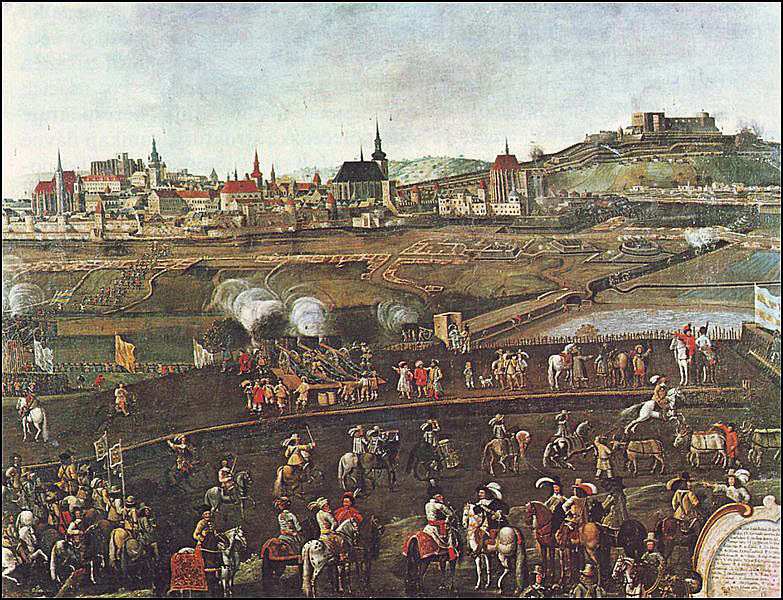
Siege works against a city at the time of the English Civil War: Storming of Bristol on 26th July 1643 during the English Civil War
On 23rd July 1643 Prince Rupert rode over Durdham Down to Clifton Church to reconnoitre the western section of the city’s defences. Gunfire was opened on the Prince’s party from Brandon Hill Fort.
Colonel Washington’s dragoons and some foot formed a garrison on Clifton Hill and were engaged by a Parliamentary attack on their position during that night which they repelled.
The determination of Colonel Fiennes is demonstrated by this raid when he had such limited resources available to him.
South of the River Avon Prince Maurice’s Cornish army began to dig siege works and bring up guns to form batteries from which to bombard the city walls.
On 24th July 1643 Prince Rupert sent an officer into Bristol with a message for Colonel Fiennes summoning him to surrender the city. Fiennes rejected the demand.
On 25th July 1643 Prince Rupert with his senior staff crossed the River Avon to meet his brother Prince Maurice in Council of War and decide how the city should be attacked.
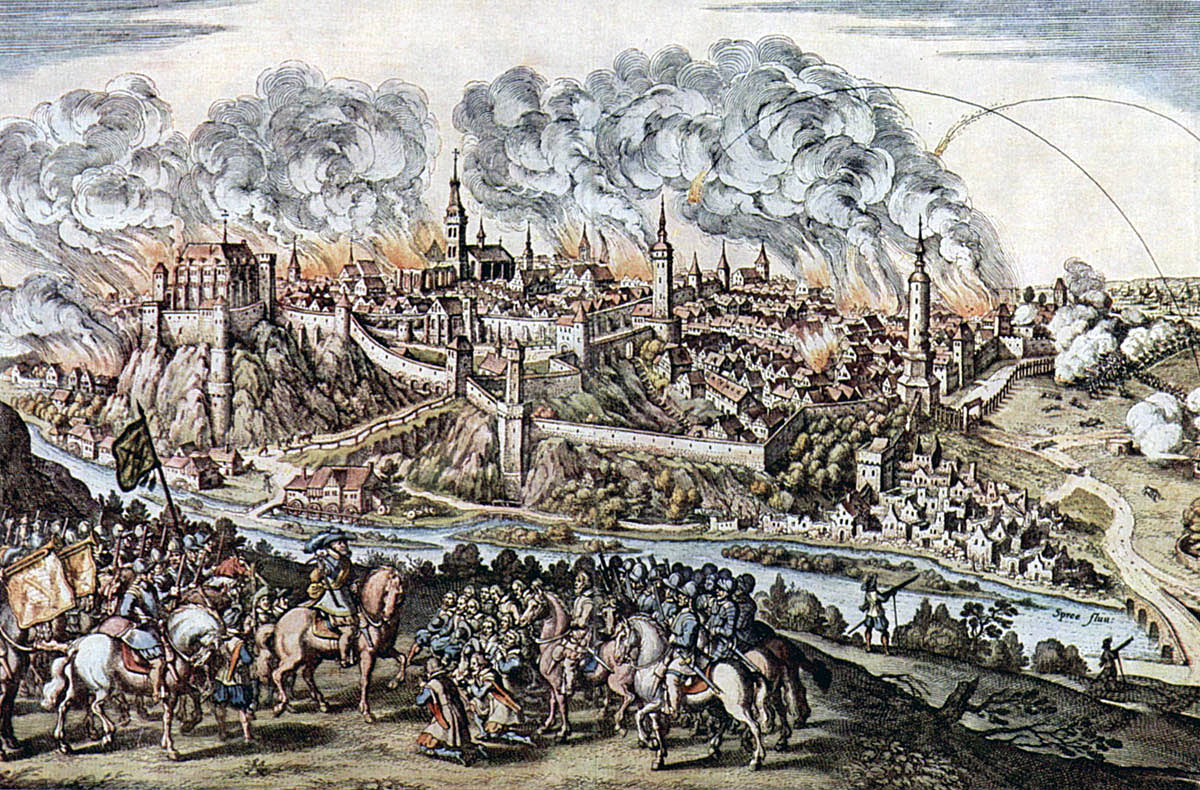
Surrender of a city under siege at the time of the English Civil War: Storming of Bristol on 26th July 1643 in the English Civil War
Prince Maurice and the senior officers of the Royalist ‘Cornish’ army urged that the city be attacked by formal siege operation. Prince Rupert and his officers were in favour of an immediate storming of the city.
Clarendon states that it was not surprising there was such a divergence of view. The area to the south of the Avon was eminently suitable for siege warfare while the defences on the north side of the river were not.
Prince Rupert’s view won and the next day was set for the general assault on Bristol. The identifying mark for the Royalist soldiery was to be an article of green clothing or a green emblem and no neckerchiefs were to be worn. The password was ‘Oxford’.
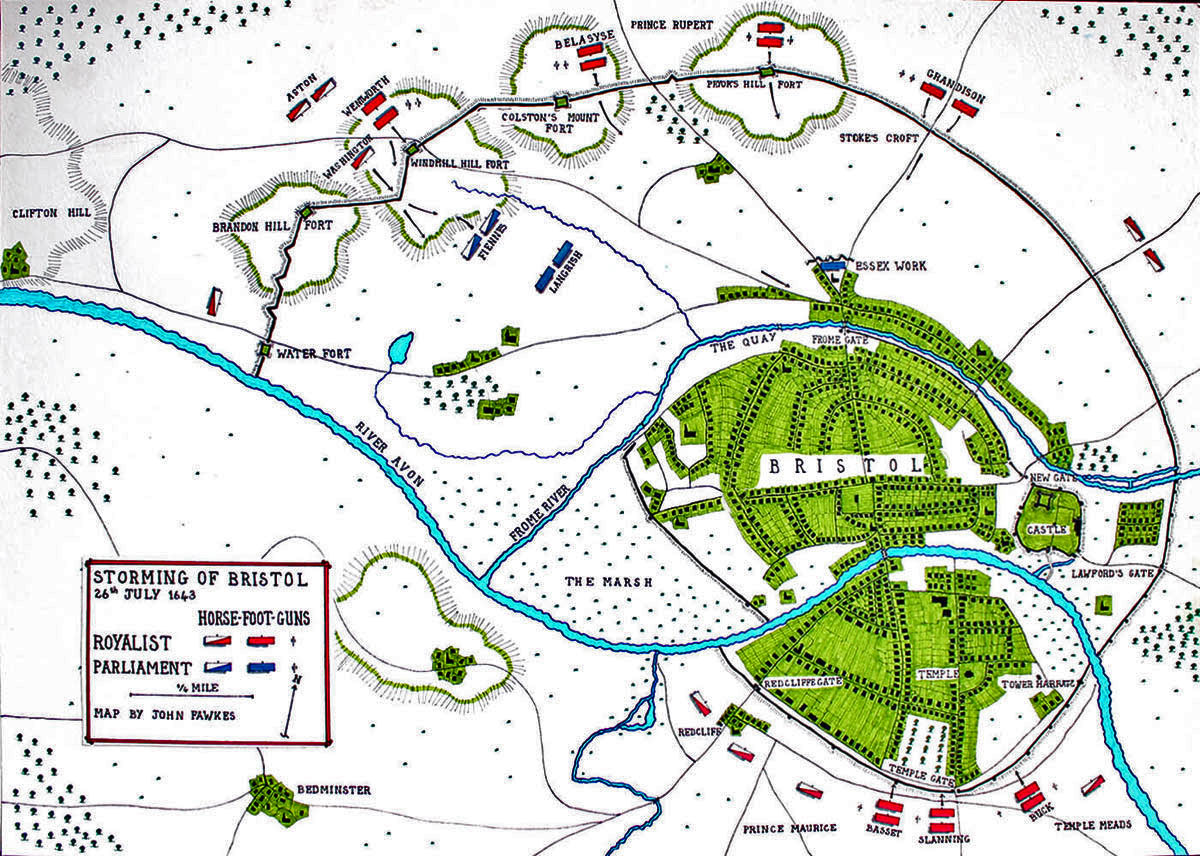
Map of the Storming of Bristol by the Royalist Army of Prince Rupert on 26th July 1643 during the English Civil War: map by John Fawkes
Account of the Storming of Bristol:
The Royalist assault on Bristol was due to begin at daybreak (around 4am) on 26th July 1643, with the attacks coordinated by the firing of signal guns.
Prince Maurice’s Cornish foot were formed in three columns, commanded by Sir Thomas Basset, Sir Nicholas Slanning and Colonel Brutus Buck to assault the walls on either side of Temple Gate. Instead of waiting for the signal guns the Cornish columns rushed to the assault soon after 3am with the first appearance of sunrise causing Prince Rupert to order the signal guns to be fired immediately.
On the north side Lord Grandison’s brigade assaulted Stoke’s Croft and Prior’s Hill Fort but were beaten back with their brigade commander mortally wounded. A petard used on the gate at Stoke’s Croft failed to do its work.
Belasyse’s attack on Windmill Fort failed due to a lack of scaling ladders to get over the wall and bundles to fill the ditch. Prince Rupert met the retreating soldiers and led them back to the attack, but was still unable to penetrate the defences at this point.
Wentworth took his men into the attack under a withering fire at Windmill Hill Fort but was repelled. To Wentworth’s right Washington and his dragoons reached an angle in the wall were they were out of sight of the main forts. Wentworth followed Washington. The Royalist columns threw grenades over the fortifications and stormed the wall. Once over they began breaking down the wall to enable the Royalist horse to follow them.
Major Hercules Langrish was posted behind this section of wall with instructions to drive back the Royalist incursion but he failed to act.
Colonel Fiennes’ Regiment of Horse counter attacked and the fighting raged at this point until the Parliamentary defenders were forced back and the Royalists penetrated into the city’s suburbs.
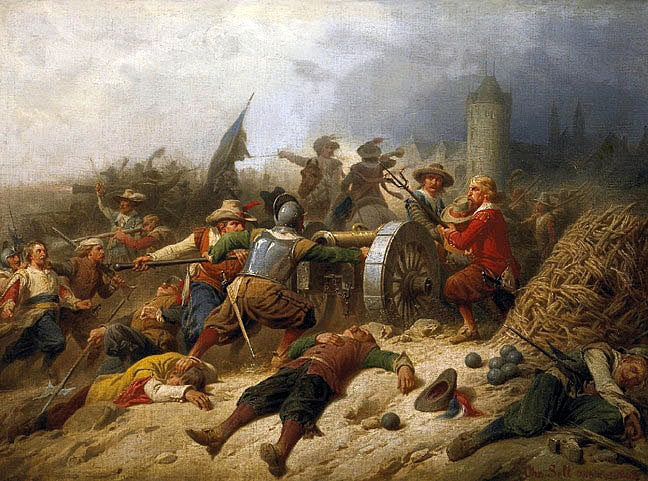
Gun in action at the time of the English Civil War: Storming of Bristol on 26th July 1643 during the English Civil War
Wentworth continued to advance taking a fortified position called ‘the Essex Work’, which the Parliamentary troops abandoned as soon as they saw the Royalist foot approaching them.
South of the River Avon the Cornish attack pressed up to the wall pushing carts into the ditch. Attempting to scale the walls the Cornish suffered heavy casualties especially among the senior officers. Colonel Buck reached the top of the wall before receiving a blow from a halberd which knocked him into the ditch fatally injuring him. Slanning and Trevannion were shot dead and Bassett, Sir Bernard Astley and Slingsby were all wounded.
On the north side of the River Avon Wentworth was joined by Belasyse and their two brigades continued to press on through the defences supported by Aston and his detachment of horse.
As the Royalists reached the inner fortifications the fighting focused around the Frome Gate which they tried to force against heavy resistance.

Dorothy Hazzard, Joan Batten and Widow Kelly leading a party of women reinforcing the Frome Gate with woolsacks and earth to keep the Royalists from breaking through during the Storming of Bristol on 26th July 1643 in the English Civil War
Among the Parliamentary defenders of the Frome Gate was a party of women led by Dorothy Hazzard who worked to re-inforce the gate with woolsacks and earth to keep out the Royalist troops.
Prince Rupert sent to his brother for 1,000 of his Cornish foot to re-inforce the assault on the Frome Gate. These troops were making their way around the walls when at about 2pm the Governor of Bristol Colonel Nathaniel Fiennes ‘beat a parley’ seeking terms to surrender the city to the Royalists. This opportunity was immediately taken up by Prince Rupert who feared the capture of the city would involve greater Royalist losses if fought to a conclusion and there was the danger that the assault might yet fail.
Fiennes clearly had little choice but to give up the fight. His Parliamentary force was beginning to break up, his soldiers, many of them simply armed citizens slipping away into the city with some surrendering or changing sides.
The terms of the surrender of Bristol were agreed by 10pm by which time the Royalists were in control of much of the city. The articles of surrender permitted the Parliamentary garrison to march out, the officers and cavalry keeping their horses and swords and all ranks carrying their personal possessions.
These terms were not kept and the Parliamentary soldiers were plundered and stripped of what they carried by the Royalist troops as they left the city. It is said this was in revenge for the plundering of the Royalist garrison after the surrender of Reading.
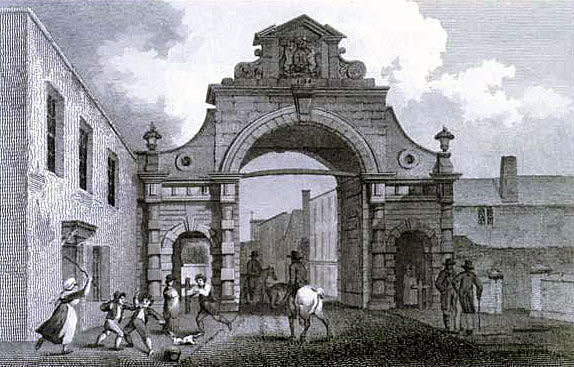
Temple Gate, attacked by the Cornish Army of Prince Maurice during the Storming of Bristol on 26th July 1643 in the English Civil War
Casualties at the Storming of Bristol:
Clarendon states of the Royalist casualties: ‘Yet the king might very well have said what king Pyrrhus did: ‘If we win another at the price, we are utterly undone.’ And truly his majesty’s loss before this town is inestimable, and very hard to be repaired. I am persuaded there were slain, upon the several assaults, of common men (but such as were tried and incomparable foot) about five hundred, and abundance of excellent officers, whereof many were of prime command and quality’.
The Royalist loss was particularly heavy among the senior officers who led the storming parties: Lord Grandison, Colonel Brutus Buck, Sir Nicholas Slanning and Colonel John Trevannion were among the dead.

William Villiers, 2nd Viscount Grandison, mortally wounded at the Storming of Bristol on 29th July 1643: picture after Anthony van Dyck
William Villiers 2nd Viscount Grandison was mortally wounded at the Storming of Bristol on 29th July 1643. Lord Grandison was a prominent Royalist Cavalry Commander. Lord Grandison captured Nantwich in Cheshire with a Regiment of Horse and some Dragoons in 1642. Lord Grandison’s Regiment of Horse was in the front line of the Royalist left wing at the Battle of Edgehill on 23rd October 1642. In December 1643 Sir William Waller surprised Lord Grandison’s regiment on his advance to Winchester and destroyed it, Grandison and a few of his officers managing to escape. Following his death at Bristol a memorial to Lord Grandison was installed in the Lucy Chapel of Christchurch Cathedral Oxford.
Parliamentary casualties were probably heavy but are not recorded.
Follow-up to the Storming of Bristol:
Following the capture of Bristol Prince Rupert went on to Gloucester where he was joined by King Charles I with additional troops from Oxford. The heavy loss incurred in storming Bristol deterred the King from making an immediate assault on Gloucester. The Royalists began a siege of the city but before this could take effect a relieving Parliamentary army commanded by the Earl of Essex arrived from London forcing the abandonment of the siege.
Essex then marched back to London. The Royalist and Parliamentary armies met in battle at the First Battle of Newbury on 20th September 1643.
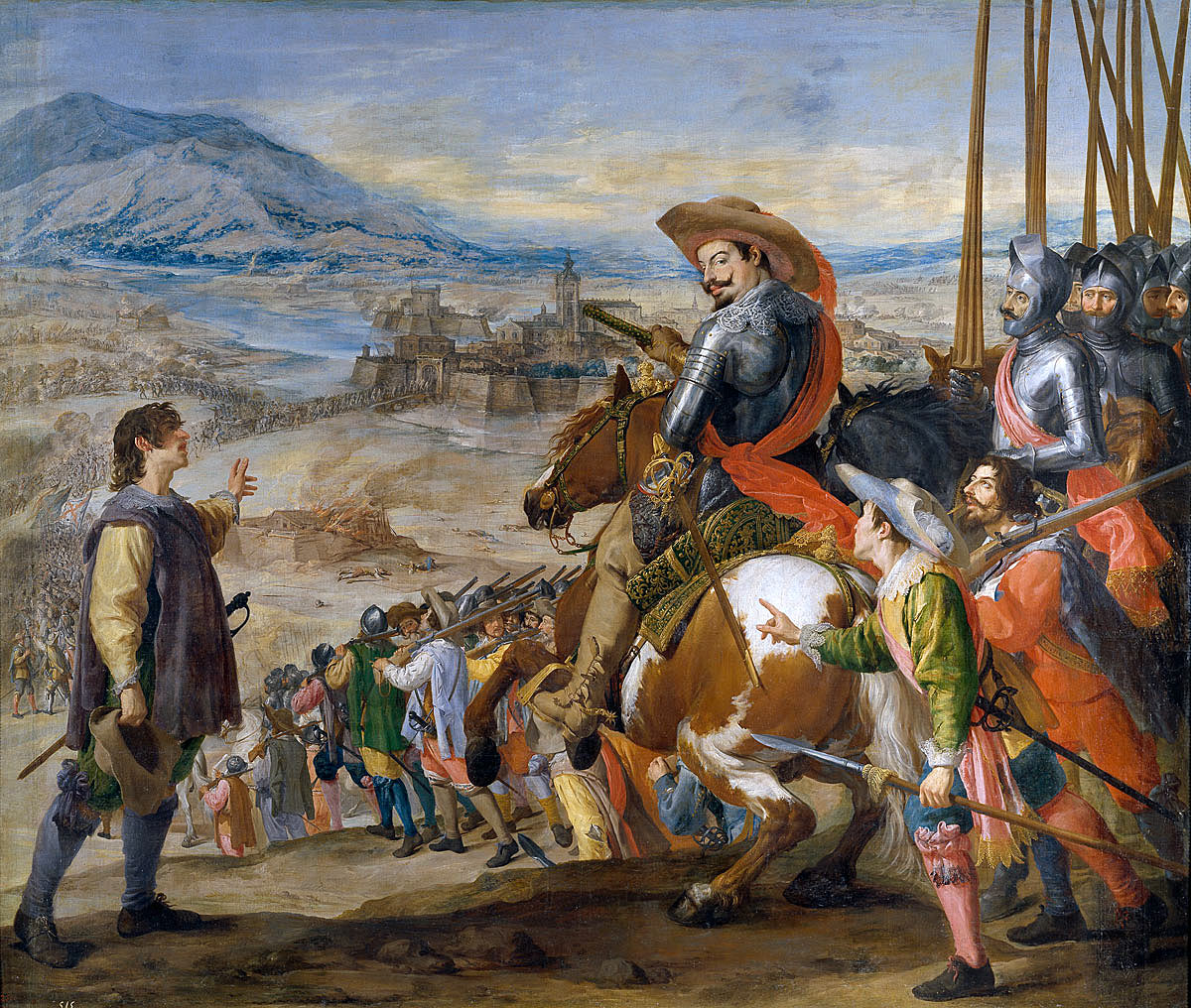
Troops approaching a city at the time of the English Civil War: Storming of Bristol on 26th July 1643 during the English Civil War
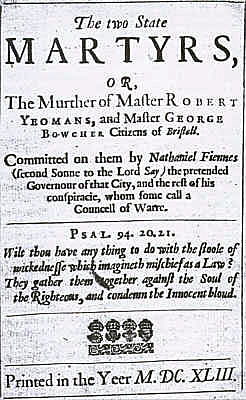
Pamphlet on the trial and execution of Robert Yeamans and George Bouchier following the plot to deliver Bristol to the Royalists on 7th March 1643: Storming of Bristol on 26th July 1643 during the English Civil War
Anecdotes and traditions from the Storming of Bristol:
- Among the weapons carried by the attacking Royalists were pikes with burning material stuck on the point. The Royalist Officer Lieutenant-Colonel Littleton galloped along the inside of the Parliamentary line with a fire-pike causing panic among garrison troops who cried out ‘Wildfire’. The fire-pikes were used to repel the attack by Fiennes’ Regiment of Horse.
- Following the surrender of Bristol to Prince Rupert the governor Colonel Nathaniel Fiennes returned to London where his opponents William Prynne and Clement Walker accused him of treachery and cowardice in surrendering the city. Fiennes was tried at St Albans and sentenced to death. Fiennes was pardoned and after Cromwell’s recapture of Bristol, which exposed the inadequacy of the city’s defences Fiennes was exonerated. However, he played no further military part in the English Civil Wars. Prynne and Walker are said to have lost property in the Royalist capture of Bristol and it may be that the trial of Fiennes was politically motivated. All the indications are that Fiennes fully performed his duty in the defence of Bristol.
- Nathaniel Fiennes’ trial and execution of the prominent Royalist Bristol citizens Robert Yeamans and George Bouchier for treason in March 1643 provoked outrage in the Royalist camp. King Charles I made every effort to save Yeamans and Bouchier and threats of retaliation on Parliamentary officers held by the Royalists were made by Royalist officials but not carried out. Yeamans and Bouchier were hung drawn and quartered outside Yeamans’ house. Fiennes was determined to intimidate the Royalist faction in Bristol and prevent any undermining of his hold on the city. At Fiennes’ subsequent trial for surrendering Bristol the execution of Yeamans and Bouchier was raised against him.
- During the Royalist assault on the Frome Gate Dorothy Hazzard, Joan Batten and Widow Kelly led a party of women in reinforcing the gate with woolsacks and earth to keep the Royalists from breaking through. Once the city fell to the Royalists Dorothy Hazzard and her husband the Reverend Matthew Hazzard left the city and settled in East Barnet then in Hertfordshire where Matthew Hazzard became the Rector. The Hazzards returned to Bristol in 1645 after the re-taking of the city by Oliver Cromwell and his Parliamentary army. Dorothy Hazzard ran a shop in Bristol High Street and was a woman of strong non-conformist religious principles. She refused to close her shop on Christmas Day and finally stopped attending her husband’s church, taking part in services in her home and establishing the Broadmead Baptist Church, described as the ‘First Dissenting Church in Bristol’. She died on 14th March 1675.
- Colonel Henry Washington who commanded the Royalist dragoons in the Storming of Bristol was the great-uncle of George Washington Commander-in-Chief and President of the United States of America.
References for the Storming of Bristol:
The English Civil War by Peter Young and Richard Holmes
History of the Great Rebellion by Clarendon
Cromwell’s Army by CH Firth
British Battles by Grant Volume I
The previous battle in the English Civil War is the Battle of Roundway Down
The next battle in the English Civil War is the First Battle of Newbury
To the English Civil War index
